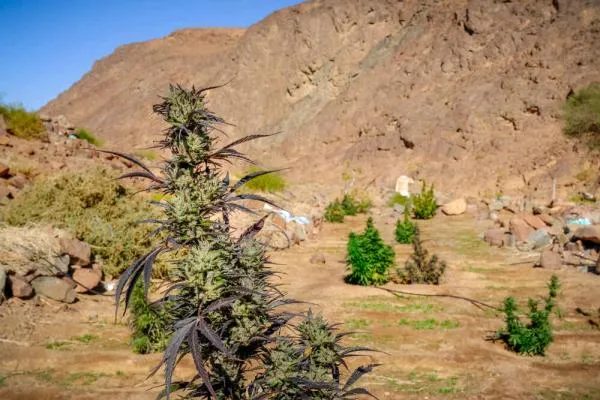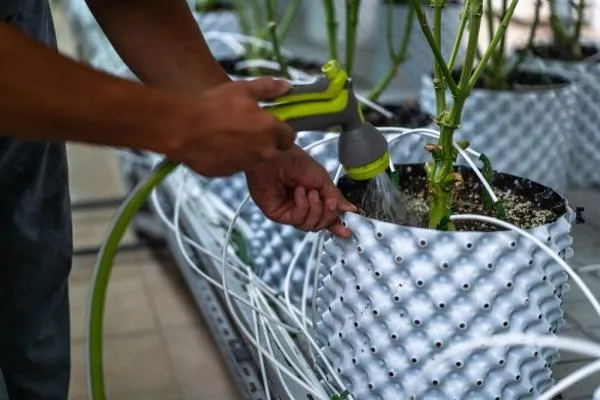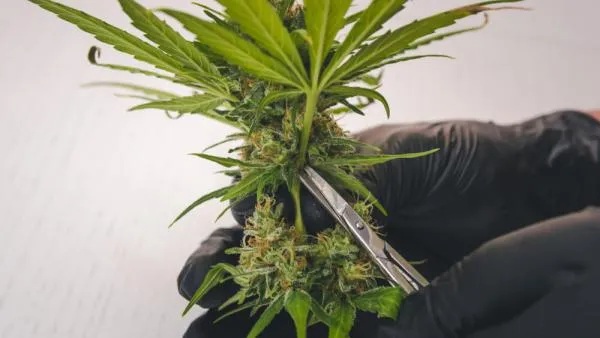If you've landed here, chances are you are pretty new to the weed-growing game.
So, first up, welcome! Growing your own ganga is up there with the most rewarding (and enjoyable, although sometimes ridiculously annoying) hobbies any self-respecting cannahead can get their hands dirty with.
But it ain't all fun and games.
There are a bunch of skills (and a certain level of base knowledge) required if you want to grow the type of cannabis plants that dreams are made of. And for those of you looking to grow indoors, one of the first things that you really need to understand fully is -
"What light schedules do you need for growing cannabis plants?"
Outdoor growers also need a general idea of lighting cycles and how they affect weed plants, as this dictates when they should plant their weed seeds and how long the plants take to mature. Indoor growers have full control over the lighting schedules, and that is what I am going to be mostly discussing here today.
That said, if you plan to grow outdoors, don't rush away too quickly. There is still plenty of valuable information here.
- Why do cannabis plants need different light cycles?
- Are all feminized seeds photoperiodic?
- Photoperiod and autoflower: Why they need different light schedules
- Light cycle for cannabis seedlings
- Light cycles for the cannabis vegetative stage
- Light cycles for the cannabis flowering stage
- Light cycles for autoflower flowering stage
- How to adjust light cycles
- Considerations for types of grow lights
- Cannabis light schedule FAQs
Why do cannabis plants need different light cycles?
Now, before I dive into the guts of the article, we need to first discuss why cannabis plants need different light cycles to begin with. To do so, we need to mention photoperiodism.
What is photoperiodism?
Photoperiodism is a big word for the way that different plants respond to light cycles.
Some plants are called day-neutral plants because their flowering isn't affected by changes in light patterns - they just keep on producing flowers after reaching maturity or when they get the right cues.
Other plants, like some cannabis cultivars, have a photoperiodic response. This means they need both light and dark periods to produce flowers. The reason for this is evolution. More specifically, cannabis plants have evolved in such a way that they use light cycles to prepare themselves for the upcoming winter season.
Light patterns, which change throughout the year, tell the plant when it's time to flower and set seed. But, by using the power of artificial lighting indoors, indoor growers can induce this flowering response at any time of the year.
Are all feminized seeds photoperiodic?
Many people get confused between the differences between 'feminized' and 'photoperiod' but they actually refer to two completely different things. Feminized refers to just the gender, meaning they will grow into female plants, whereas photoperiod simply means that the plant responds to light.
However, in the cannabis industry 'feminized seeds' are often been labelled this way as a shorter way of saying 'feminized photoperiod seeds'. On the other hand, photoperiod cannabis can actually be either male or female in gender, so to keep things simple, if it is specifically female photoperiodic plants you're after, just stick to buying from the feminized seed category.
Photoperiod and autoflower: Why they need different light schedules
Thanks to the hard work of breeders over the last 20 or so years, we now have a whole new set of weed strains referred to as 'autoflowers'.
Unlike their photoperiodic kin, autos will progress through their lifecycle (seedling, vegetative growth, flowering stage) automatically, no matter the lighting schedule that they are exposed to. This is great for not only home hobby growers, but really anyone looking to maximize their growing area.
Why?
Because, unlike photoperiod strains, autos can be grown under any lighting schedule from start to finish. Say you want to set up a perpetual harvest - that is, where you stagger your plantings to have a continuous supply of weed to harvest each month or so, instead of a large crop all coming down at one time.
This can be tricky with photo strains, which require different light schedules depending on their stage of life. But with autos, all you need to do is keep them under 18-24 hours of light per day and they will progress through their lifecycle without any hiccups whatsoever. In one grow room (or tent), you can easily have plants at different stages of life, making it easier to maintain a constant supply of weed.
For the rest of this article, we will be focusing on indoor-grown photoperiod strains and the light cycles that work best for each stage of growth.
Light cycle for cannabis seedlings
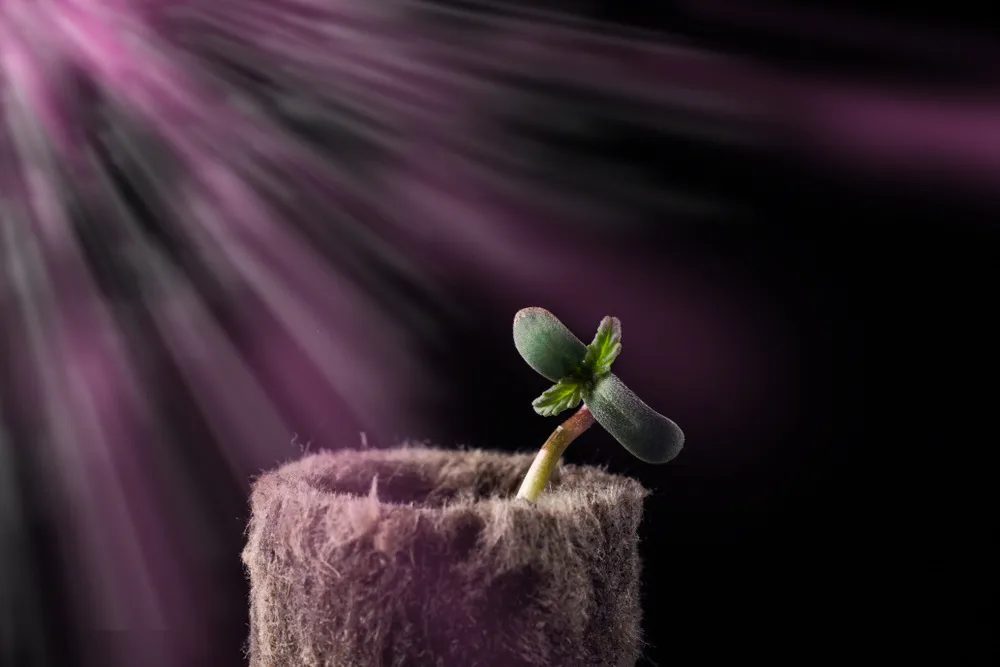
When you first put your seeds into the soil, coco-coir, rockwool, peat moss (or whatever growing media you are planning to use), it's important to dial things in perfectly from the very beginning.
Weed seedlings can be quite fragile and getting them off to the right start will grow strong, healthy plants.
So, what light cycle is best for seedlings?
For the first week or two (until they develop their first few sets of true leaves) weed seedlings need 18 hours of light and 6 hours of darkness. Seedlings like a more blue-spectrum light source, so if you are using fluorescent lights, make sure they have a color temperature of around 6500K.
You will also want to keep the humidity pretty high (around 75% to 80%) and the temperatures in the mid-to-high 70s, dropping slightly for the lights-off period.
I recommend starting your weed seedlings in a germination dome or box with its own light. Seedlings do not need the same type of light intensity as vegging or flowering plants, so setting up an array of CFLs, T5 fluros, or even a low-powered LED panel works perfectly. This also allows you to get your next batch of seedlings under way in the last few days before you harvest your last crop.
Light cycles for the cannabis vegetative stage
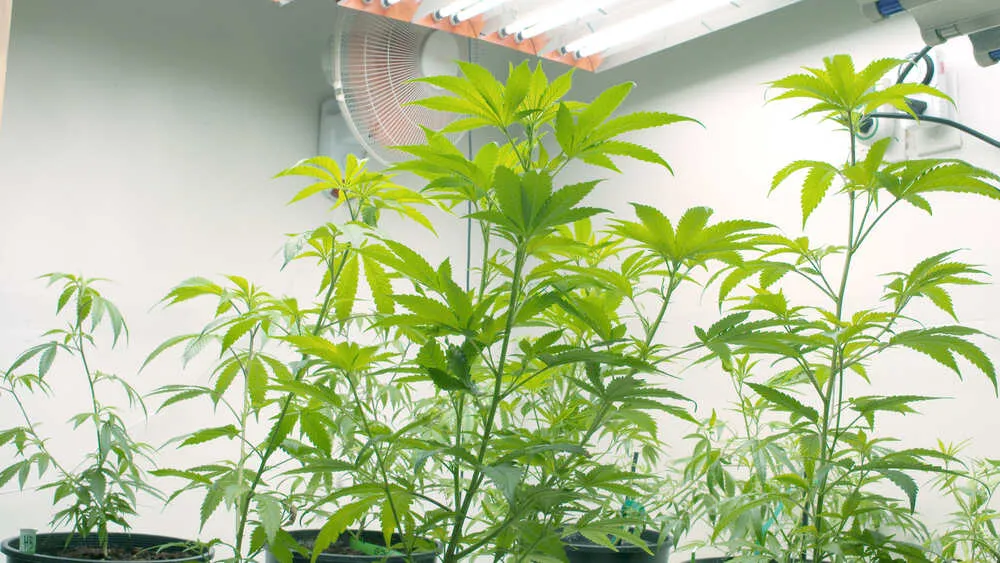
Once your seedlings grow their 'true' set of leaves (the ones that look like weed leaves), it's time to ramp up the light intensity - but not the timing.
Weed plants in the vegetative stage love 18 hours of light and 6 hours of darkness. That's it - super simple. Just like seedlings, vegging plants like light on the bluer end of the spectrum.
By keeping the light schedule set to 18/6, indoor growers can force any photoperiod strain to stay in the vegetative growth stage for as long as they like. This is handy if you are trying to grow one huge plant, keep a mother plant to clone from, or if you live in a state/country that only allows a specific number of plants to be grown at one time.
Light cycles for the cannabis flowering stage

As soon as you are ready for your plant (or crop) to start flowering, you need to cut back the lighting schedule.
To force a weed plant into the flowering growth stage, you just reduce the lighting to 12 hours per day. You will also want to change the light spectrum to one that is more on the red/orange end of the spectrum, as this mimics the lighting conditions in nature during autumn.
Light cycles for autoflower flowering stage
Again, autoflowering strains are super simple. Just choose a light timing (18/6, 20/4, 22/2, or 24/0), and stick with it until those buds are ready to harvest.
As for the best light spectrum for autos, I always recommend that new growers just go out and buy a decent LED panel that allows for spectrum variation. Don't be tempted by the cheap, shitty LED panels that have flooded the market. More on this later.
How to adjust light cycles
Again, super simple.
All you need to do is grab an electric timer from your local hardware store (or online), plug it into the wall and then plug your grow lights into the timer. They are usually super cheap ($5 to $10) and allow you to set a specific schedule for your lights to turn on and off.
There are more expensive digital timers on the market that can be paired with a phone app, but for most indoor growers, the basic timers work perfectly fine.
Considerations for types of grow lights
Up until a few short years ago, HID grow lights were the gold standard for all indoor weed cultivators, and for a good reason. They offer the best light output for the money spent, but they do have their downsides. Running costs can be high, and you have to handle all the heat that these lights pump out. That can mean a lot of additional expenditure in setting up cooling systems like air conditioners, exhaust fans and ducting.
Most growers (me included) now prefer to use a decent LED panel - or a mix of both LED and HID options, depending on the size of the grow.
All the better options use Samsung LEDs and are incredibly easy to set up. They also produce far less heat than their HID counterparts, cost way less to run thanks to their lower wattage requirement, and some allow you to fine-tune the spectrum to your exact liking.
I have used and tested literally dozens of LED panels over the years, and I can confidently say that there are a lot of lousy options out there. Do yourself a favor and stay away from the really cheap options.
I'm not saying you need to spend thousands on your first light, but do your research and invest in a decent, reputable brand. It will make all the difference in the quality and yield of your plants.
Cannabis light schedule FAQs
How much light do cannabis plants need?
That depends on what part of their life cycle they are in.
You will want to keep your seedlings and vegging plants under 18 hours of light per day with 6 hours of darkness, while flowering plants require a 12/12 split.
Autos can be grown under 18 to 24 hours of light per day, with no darkness required.
When should you switch to 12/12 light cycle?
That’s dependent on how big you want your plants to grow, but most home indoor growers let their plants veg for 4 to 7 weeks before flipping the light schedule over to 12/12.
How long after switching to 12/12 will you see buds?
Again, this depends on how long you have vegged your plants for, but most growers see buds forming around two weeks after switching to 12/12. Don't worry if it takes slightly longer than this, but by 4 weeks after switching to 12/12, you should see proper flowers forming.
Does more light mean bigger cannabis yields?
Yes, but only to a point. It is possible to give your plants too much light, which can cause them to become stunted or burn. It's all about finding the right balance for your specific set up and strain of weed you are growing.
What light intensity is best for cannabis?
Weed plants are light-hungry little sons of guns and can handle a surprisingly heavy light intensity.
Seedlings do better under less intense light, but as soon as they are ready to grow 'properly,' you want to ramp up the intensity. If you only have one grow light, just raise it up a bit to reduce the intensity.
For vegging plants, the general rule of thumb is between 400 and 800 µmol/m²/s (micromoles per meter squared per second). Flowering plants can handle even more, up to 1000 µmol/m²/s.
How far should grow lights be from your plants?
This depends on a range of factors - the type of light, the size and intensity settings of your light, how old your plants are, and even the strain of weed you are growing.
If you are growing under a decently powered LED (or a HID), hang the light about 1 meter (3 feet) above seedlings and slowly lower it as the plant develops into the vegetative stage until it is about 30 to 50 cm (12 to 20 inches) away.
What happens if your light cycle goes wrong?
This isn't the biggest deal for autos, but it can be a massive issue for photoperiod strains.
The most common way for a female plant to turn into a hermaphrodite (a plant that develops both male and female reproductive parts) is due to a light cycle interruption. This can also lead to light stress, and a decrease in overall yield and potency.
As long as you have a decent timer attached to your light, this shouldn't happen. Just be sure to check on your setup every once in a while, to make sure everything is running smoothly.




